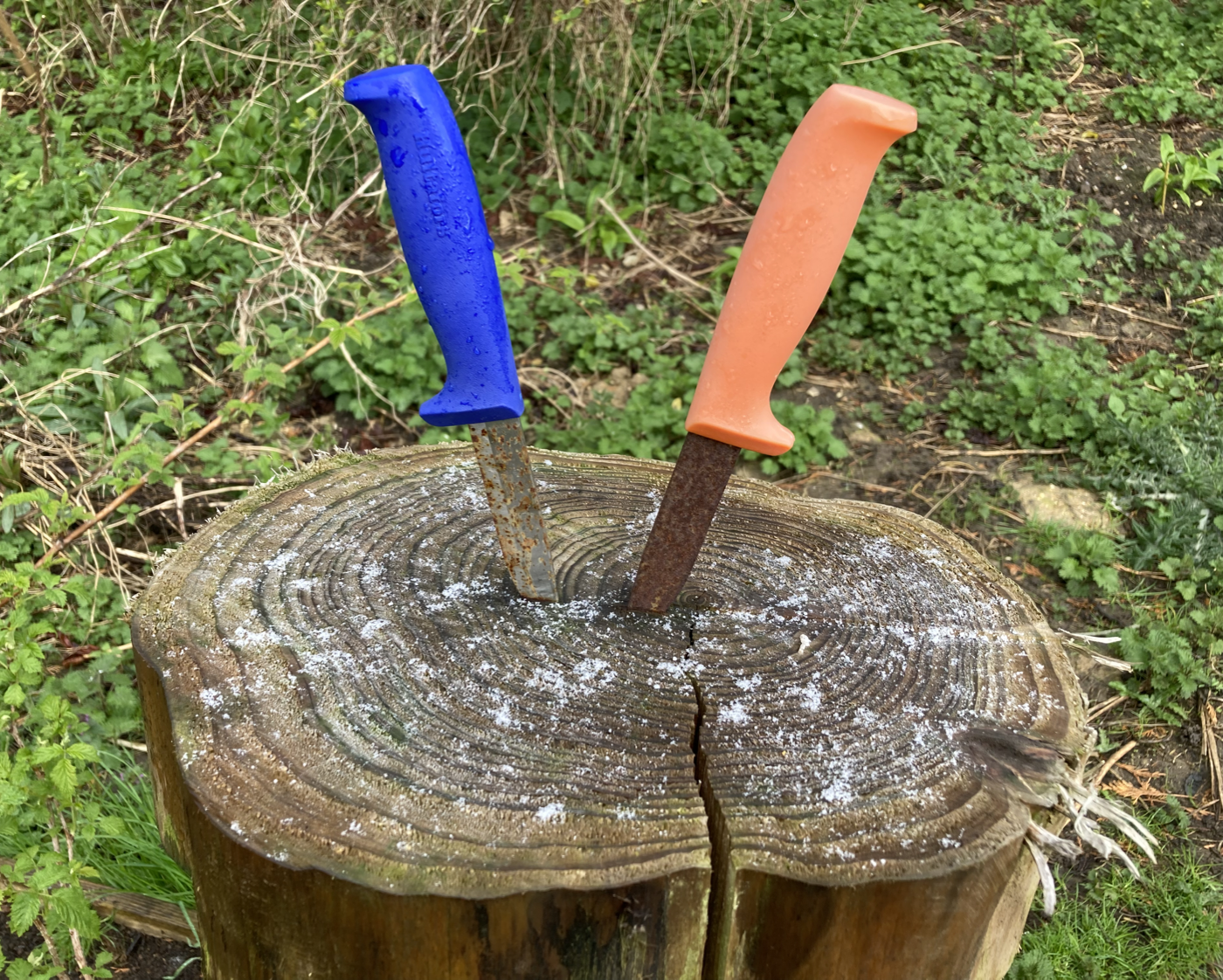Beginners guide to knife making - Corrosion Part 1
Beginners guide to knife making - Introduction.
A journal entry a year in the making!
In this Journal entry we look at the effect of environmental conditions on representative knife steels and compare the corrosion resistance of each type of steel through a year long experiment.
Beginners guide to knife making - What is corrosion?
The generally accepted definition of corrosion is: The deterioration of a material, usually a metal, that results from a reaction with its environments (NACE International)
Corrosion in iron and steels is commonly known as rust.
Generally, rusting occurs when the iron or steel is in contact with both water and oxygen, this causes a chemical reaction, the product of which is iron oxide which can exist in a number of forms. Rusting is therefore an oxidisation process.
Of the different iron oxide products, two main ones interest us with respect to knife steels. The first is the red/brown flaky form of rust Fe2O3.H2O known as hydrous ferrous oxide or hematite.
This form of rust is not stable and is constantly flaking away exposing more of the parent material to the environmental conditions until all of the parent material is converted to iron oxide.
Beginners Guide to Knife Making - The many colours of rust.
Black rust, Fe3O4 or magnetite is a far more stable compound which does help form a barrier against further corrosion damage occurring. This form of rust is the basis for chemical conversion coating processes like hot gun blueing. The downside, is that, under the right conditions black rust converts easily into red rust making it highly reactive to the presence of moisture. For this reason, chemical conversion coatings are often used in conjunction with oil to protect the surface. Not entirely practical for the average outdoor knife blade unless constantly cared for.
Beginners guide to knife making - What is a forced Patina and does it work to help prevent rust?
A Patina is discolouration of a carbon steel blade, naturally occurring through use as the knife is exposed to moisture, salts and acid, typically from cutting food stuffs. This discolouration is actually a layer of magnetite that is a few nanometers thick. If kept clean and dry, this layer will help prevent red rust forming.
It has become quite common for people to ‘force’ a patina on a blade, sometimes in ornate patterns, to take advantage of its protective properties without waiting for it to build up over time. This is often done by applying an acidic paste to the blade and leaving it to react with the metal. Common household pastes used for this purpose include mustard and ketchup!
Beginners Guide to Knife Making - Forced patina on a carbon steel knife blade using mustard paste.
Do patinas work to prevent corrosion? Within certain limits they do but not without constant care and attention i.e. drying the blade and ideally keeping it oiled. If a patina is exposed to the elements with no care, the magnetite will, over time, convert to hematite and promote red rusting.
Beginners guide to knife making - Does stainless steel rust?
Whilst stainless steels are far more rust resistant than carbon steels, they are not entirely inert and will over time start to rust unless properly cared for.
In Stainless steels containing more than 10.5% Chromium, the Chromium oxidises on the surface of the blade forming a skin of Chromium oxide approximately 5 nanometers thick. This skin is both stable to normal environmental conditions and self healing, meaning that if it gets scratched or otherwise damaged as you are using the knife, a new layer of chromium oxide will form protecting the steel. This self healing action only works if the blade is exposed to oxygen.
One mechanism for stainless steels to start rusting is regular exposure to environmental conditions that cause the protective layer to break down in localised areas on the surface of the blade. This type of rusting is known as pitting corrosion and is common in wet environments where Chlorine may be present I.e. coastal atmospheres, salts and rainwater and even tap water with high levels of Chlorine.
Beginners Guide to Knife Making - pitting corrosion on a stainless steel knife blade
A second mechanism for starting rust in stainless steels is less obvious. By excluding the oxygen and preventing the chromium oxide from forming i.e. under a painted on coating or perhaps the glue holding handle slabs on, the unprotected ferrous material can start to break down and rust.
Beginners guide to knife making - What is Galvanic corrosion?
The final form of corrosion that can commonly affect knifes is galvanic or dissimilar metal corrosion.
Most non ferrous metals like aluminium, copper, brass and chromium etc form a stable oxide layer that prevents further corrosion. When these metals are next to each other or a ferrous metal, in the presence of moisture, an electrical coupling is formed.
The size of this electrical coupling depends on how far apart the dissimilar metals are on the galvanic scale. At one extreme, the noble (less active materials) like Gold, form a cathode whilst at the other extreme, less noble more reactive materials like Magnesium, form an anode. This can result in a voltage difference of up to 1.85v. In simple terms this voltage difference causes a reaction that eats the two materials away - think electroplating in reverse. Engineering best practice is to limit the potential difference between dissimilar materials to no more than 0.25v to prevent galvanic corrosion issues.
Beginners Guide to Knife Making - Example of galvanic corrosion in dissimilar metals.
Picture Credit - www.reddit.com
Taking a typical example, a steel blade riveted on with brass or copper rivets, the potential difference between these materials is around 0.5v more than enough to cause galvanic corrosion to occur. This risk can be mitigated by excluding moisture through glueing on the scales with a high quality solvent based epoxy resin.
In part two of this journal entry, we will take a look at the ‘Big Corrosion Experiment’ comparing typical carbon steel and stainless steel knives as they corrode, exposed to all 4 seasons over a year.








